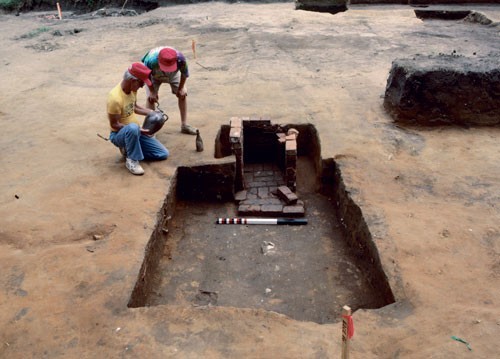
Jug, Old Bridge, New Jersey, 1805–1827. Salt-glazed stoneware. H. 12". (Courtesy, York County Historical Museum; photo, Gavin Ashworth.)

Overview of the excavated Civil War hut with excavators examining the recovered New Jersey stoneware jug. Note the firebox in the upper part of the feature. (Photo, James River Institute for Archaeology.)

Detail of the hearth base and firebox of the hut illustrated in fig. 2. (Photo, James River Institute for Archaeology.)

Detail of the impressed “GIN” mark and the coggle wheel decoration of fish and berries on the jug illustrated in fig. 1.

Jug, Old Bridge, New Jersey, 1805–1827. Salt-glazed stoneware. H. 14". (Private collection; photo, Gavin Ashworth.)

Detail of the impressed marks on the jug illustrated in fig. 5.

Stoneware jugs. Left: Baltimore, ca. 1860. H. 11 1/2". Right: Old Bridge, New Jersey, 1805–1827. H. 12". (Courtesy, York County Historical Museum; photo, Gavin Ashworth.) Both of these complete jugs were found in the excavation.
In almost all instances, when utilitarian ceramic vessels survive the passage of time we lose the history of their everyday use. We may ask many questions about a simple stoneware jug—Who were the original owners? How was it used? Did its use change through time? Why did it survive?—but expect few answers. However, an opportunity to address some of these questions arose from the discovery of an early-nineteenth-century New Jersey example (fig. 1).
The jug was found in 1989 during archaeological excavations of a Civil War encampment in Yorktown, Virginia, prior to the development of a housing complex. Archaeologists from the James River Institute for Archaeology uncovered a roughly rectangular feature filled with dark brown and gray sandy loam that stood out against the surrounding orange clay subsoil (fig. 2). Further excavation revealed a small, semi-subterranean “dugout” dwelling no more than 7.5 feet long and 6 feet wide with a partially intact brick chimney projecting from one end (fig. 3). The feature was interpreted as the remains of a Civil War–era winter hut.[1]
Among the artifacts recovered in the fill of this feature is an intact one-gallon salt-glazed jug with rouletted decoration and impressed with the word “gin” (fig. 4). The vessel is attributed to one of the potteries in Old Bridge, New Jersey. The potting operations at Old Bridge date as early as 1805, when James Morgan Jr., Jacob van Wickle, Nicholas van Wickle, and Branch Green established a “Manufactory of Stone Ware,” which continued under various owners to at least 1823 and possibly as late as 1827. The stoneware is distinguished by fish and berry coggle wheel ornamentation, the decoration seen on the excavated example.[2] For comparison, a similar antique jug, without any history and from the same New Jersey pottery, is shown in figures 5 and 6.
The historical record of Civil War activity in Yorktown suggests that the hut was built and occupied by Confederate forces during the winter of 1861–1862 and subsequently occupied and/or backfilled by newly arrived Union troops in May 1862. The Union troops occupied Yorktown through July 1864. Which troop might have owned the jug is unclear in the archaeological record, but the best inference suggests a Union origin.
Most interesting about the jug, which was made in the 1820s or possibly even earlier, is that it had been in active use for at least forty years. In contrast to the newfangled cylindrical shape of another one-gallon jug (fig. 7, left), found in the same feature and probably made in Baltimore after 1860, the graceful ovoid form of the New Jersey gin jug (fig. 7, right) was certainly out of style.[3] In addition, the base of the jug exhibits quite a bit of heavy wear, indicative of constant use.
It is tempting to speculate as to the contents of either jug in the military context. Did the New Jersey jug actually contain a winter’s ration of gin, or did it merely hold cooking oil? Perhaps future residue analysis can provide additional fodder for both military and ceramic historians to ponder. For now, the simple artifact provides confirmation of the relative long-term use of an everyday object—in contrast to the disposable orientation of twenty-first-century America.
Robert Hunter, Editor, Ceramics in America; somerwell@aol.com
Hank D. Lutton, Graduate student, Department of Archaeology, Boston University; hdlutton@bu.edu
Garrett R. Fesler, Matthew R. Laird, and Hank D. Lutton, “‘Beautiful Confusion’: The Archaeology of Civil War Camp Life in an Urban Context,” in Huts and History: The Historical Archaeology of Military Encampment during the American Civil War, edited by Clarence R. Geier, David Gerald Orr, Matthew B. Reeves (Gainesville: University Press of Florida, 2006).
M. Lelyn Branin, The Early Makers of Handcrafted Earthenware and Stoneware in Central and Southern New Jersey (Rutherford, N.J.: Fairleigh Dickinson University Press, 1988), pp. 97–98.
See John E. Kille, “Distinguishing Marks and Flowering Designs: Baltimore’s Utilitarian Stoneware Industry,” in Ceramics in America, edited by Robert Hunter (Hanover, N.H.: University Press of New England for the Chipstone Foundation, 2005), p. 115.
